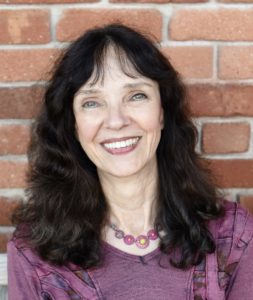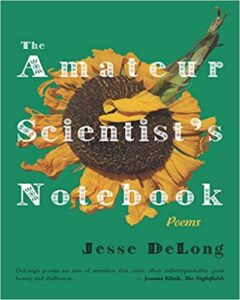
Review of The Amateur Scientist’s Notebook: Poems by Jesse DeLong.
Reno, Nevada: Baobab Press, 2021. Paper, 62 pages. $16.95.
Florets, phosphorus, birds, water, and light are recurrent images in Jesse DeLong’s debut collection, The Amateur Scientist’s Notebook: Poems, which explores the evolving dynamic of a couple, a man and a woman, whose complicated connection to each other is embedded in earthly ecosystems in a universe where interactions are driven by the fundamental forces: gravity, the weak force, the strong force, and electromagnetism. It’s an ambitious collection characterized by turns with beauty, clarity, and intricacy.
A floret is a one of the small flowers that make up a composite flower head, such as that of a sunflower. So too, the individual poems in The Amateur Scientist’s Notebook are like florets that make up the collection. The first poem is called “Florets,” and it is shortly followed by “Floret as Water,” “Floret as Phosphorus,” and “Floret as Bird.” “Florets” begins with these lines:
The struggle of scale begins
in a sunflower. Floret: sharp of petals, stem-bright,
it starts—to fill air, to feed earth, to forge
from root to flower
Thus, a sunflower, the poem, the book, and a story of two people all begin.
To understand DeLong’s poems, it helps to know what phosphorus and its cognates are. Phosphorus, atomic number 15, is an element that does not occur naturally in the free state because of its great reactivity but is essential for life, where it is found primarily in the phosphate ion. When elemental phosphorus is isolated in the laboratory, it gives off a glow called phosphorescence. A phosphor is a synthetic substance that emits a similar glow. All of this is relevant to DeLong’s poems: the terms phosphorus, phosphate, phosphorescent, and phosphor are abundant in The Amateur Scientist’s Notebook. DeLong deftly weaves the science into the poems both as metaphor and as fact. In “Floret as Phosphorus,” he says, “…When you draw close / I feel phosphorus & not phosphor,” i.e., he feels both himself and his beloved to be the real thing, not a simulacrum, and their love is phosphorescence, not an imitation light.
The book includes a nine-poem sequence called “Fieldguide to the Southeastern Idaho Phosphate District.” In addition to being found in the DNA and RNA of all living things, phosphate occurs in some rocks and can be mined for use in fertilizers. Historically, phosphate mining has been extremely destructive to the environment, leaving behind open pits and waste rock dumps and also contaminating streams with selenium that ultimately kills both wildlife and animals such as horses and sheep. In DeLong’s poems, a damaging relationship unfolds in a damaged land. From “[Structural Setting of Bird & Phosphor]”: “I am not who you think I am & so I hurt you. You are not who I think you are & so you hurt me.”
DeLong often addresses his beloved as “bird.” In “Floret as Bird,” a six-part poem, he tells her, “Bird, know / the birds are feasting.” In the final section, when he sees two cardinals ruffling their wings against each other and knocking each other down, he says, “Tell me we will never be / those birds.” Throughout the book, actual birds surround the humans: “Birds forage for seeds” and “birds bleat” (“Floret as Water”); “A platoon of birds, so large they cover the canopy, lift from the field & demand the sky” (“Table 2.1”); “A bird gongs on the after-autumn air” (“On Uprooting”).
Water, a basic necessity of life, is also necessary to these poems. In them, we see river water, pond water, trough water, storm water, glasses of water, and the “water-worn pages of a book” (“On Air & Angels: The Reconciliation of Twos”). But water can be dangerous as well as sustaining, and humans, whose bodies are mostly water, can
drown in our own
flesh.
We, bloated & barely
breathing, begin to
surface here. (“The Aether Notes”)
The florets, phosphorus, birds, and water within the poems, as well as the poems themselves, are woven together with light: “Bird, I light a lamp” and “phosphorus, water & light. A sunflower / bound of small flowers blooming in the sun” (“Florets”); “See, a man steps into the net of lamplight. / He holds a glass of water…” and “A disoriented swallow / flies around a lighted window, exhausted” (“Floret as Phosphorus”).
In The Amateur Scientist’s Notebook, the forces of the universe become embodied in human interactions. In the prose poem, “Newton & the Law of Celeste’s Body,” Celeste explains gravity to Newton: “Attraction…is controlled by the strength of a body & its proximity to another. If a girl is closer…her force is stronger.” In “The Aether Notes,” the electroweak force (which combines electromagnetism with the weak force responsible for some types of radioactive decay) and the strong force (which holds atomic nuclei together) become the characters the Electroweak (the poet’s girlfriend) and the Strong (a man she speaks to at a bar). DeLong concludes that the forces “are all different aspects / of the same phenomenon—love.”
In addition to lineated poems, prose poems, and hybrid poems with lineated and prose components, The Amateur Scientist’s Notebook includes two poems constructed in the form of tables, “Occurrence of Phosphorus Intermediates in Florets” and “Table 2.1.” Like the other poems in the book, these two poems combine human concerns with science in the context of particular ecosystems. “Table 2.1” shows greenhouse gases woven into the fabric of everyday life. The table tells us that carbon dioxide increases with fossil fuel burning and deforestation. It also describes DeLong’s father working as a logger. Similarly, after showing that chlorofluorocarbons are found in “refrigerators, foam / insulation & packing, / previously spray cans,” the table presents the poet’s little brother spraying a ladybug with Lysol while his father loads a broken refrigerator into the back of a truck. The table continues with information on the sources of methane and nitrous oxide in ecosystems and examples of how these gases have fit into the lives of the poet’s family members.
The Amateur Scientist’s Notebook brings to mind Theodore Roethke’s greenhouse poems and Muriel Rukeyser’s The Book of the Dead, with its melding of science, the environment, and human disaster. The collection gives us florets, phosphorus, birds, water, and light, along with forces, logging, ladybugs, spray cans, broken refrigerators, and many other objects and elements we encounter in our sojourn on this planet, with its lovely, tattered ecosystems, where the best thing we can find is love.

A lovely and understanding review, Lucy. All the “L’s of “floret,” “light,” “love,” “longing,” “ladybug,” “life,” and “electroweak” flow in the landscape–well-planted and insightful.
Thank you, Rod!